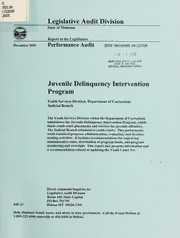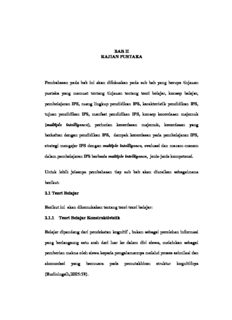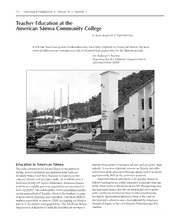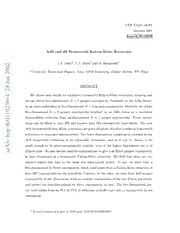
AdS and dS Braneworld Kaluza-Klein Reduction PDF
Preview AdS and dS Braneworld Kaluza-Klein Reduction
CTP TAMU-30/01 October 2001 hep-th/0110238 AdS and dS Braneworld Kaluza-Klein Reduction I.Y. Park1, C.N. Pope1 and A. Sadrzadeh1 2 0 0 Center for Theoretical Physics, Texas A&M University, College Station, TX 77843 2 ‡ n a J 8 ABSTRACT 2 4 We obtain new results for consistent braneworld Kaluza-Klein reductions, showing how v 8 we can derive four-dimensional N = 2 gauged supergravity “localised on the AdS4 brane” 3 as an exact embedding in five-dimensional N = 4 gauged supergravity. Similarly, we obtain 2 0 five-dimensional N = 2 gauged supergravity localised on an AdS brane as a consistent 1 5 1 Kaluza-Klein reduction from six-dimensional N = 4 gauged supergravity. These embed- 0 / h dings can be lifted to type IIB and massive type IIA supergravity respectively. The new t - AdSbraneworldKaluza-Klein reductionsaregeneralisations ofearlier resultsonbraneworld p e reductions to ungauged supergravities. The lower-dimensional cosmological constant in our h : v AdS braneworld reductions is an adjustable parameter, and so it can be chosen to be i X small enough to be phenomenologically realistic, even if the higher-dimensional one is of r a Planck scale. We also discuss analytic continuations to give a de Sitter gauged supergravity in four dimensions as a braneworld Kaluza-Klein reduction. We find that there are two distinct routes that lead to the same four-dimensional theory. In one, we start from a five-dimensional de Sitter supergravity, which itself arises from a Kaluza-Klein reduction of type IIB supergravity on the hyperbolic 5-sphere. In the other, we start from AdS gauged ∗ supergravity in five dimensions, with an analytic continuation of the two 2-form potentials, and embed the four-dimensional de Sitter supergravity in that. The five-dimensional the- ory itself comes from an O(4,3)/O(3,2) reduction of Hull’s type IIB supergravity in ten 7+3 dimensions. 1 Research supported in part byDOEgrant DOE-FG03-95ER40917 1 Introduction An intriguing proposal that has attracted much attention in recent times is the suggestion by Randall and Sundrum that four-dimensional physics can effectively arise from a five- dimensional theory that admits anti-de Sitter spacetime, but not Minkowski spacetime, as a vacuum [1]. In the ground state four-dimensional Minkowski spacetime is embedded as a “3-brane” in AdS via the Poincar´e or horospherical description, with 5 dsˆ2 = dz2+e 2k z dxµdxνη , (1) 5 − | | µν where the AdS metric dsˆ2 satisfies Rˆ = 4k2gˆ in the bulk. The effective four- 5 5 MN − MN dimensional gravity can be investigated at the linearised level by replacing the Minkowski metric η byη +h , and studyingthe equation governing small fluctuations. This leads µν µν µν to the conclusion that gravity is localised on the brane. One can consider the situation beyond the linearised level, by introducing a general four-dimensional metric ds2, and writing 4 dsˆ2 = dz2+e 2k z ds2. (2) 5 − | | 4 One can easily show that in the bulk the Ricci tensor of dsˆ2 satisfies the Einstein equation 5 Rˆ = 4k2gˆ if the Ricci tensor of the four-dimensional metric satisfies R = 0 (see, MN MN µν − for example, [2, 3, 4, 5, 6]). This approach was used, for example, in [3] to study the global 5-dimensional geometry resulting from having a four-dimensional Schwarzschild black hole “on the brane.” Equation (2) has very much the structure of a Kaluza-Klein reduction ansatz, and indeed one can view it as giving a consistent embedding of D = 4 pure Einstein theory with equation of motion R = 0 in D = 5 Einstein theory with a negative cosmological µν constant, with equation of motion Rˆ = 4k2gˆ . More precisely, the embedding is an MN MN − exact one if the modulus sign is omitted in (2), giving dsˆ2 = dz2+e 2kzds2. (3) 5 − 4 Thisnowsatisfiesthefive-dimensionalequation notonlyinthebulk,butalsoatz = 0itself, whereas previously (2) would have given a delta-function contribution to Rˆ , owing to MN the discontinuity in the gradient of the metric there. This Kaluza-Klein theme was developed in [4], where it was shown that the above embedding could be extended to a fully consistent Kaluza-Klein reduction of N = 4 gauged supergravity in D = 5 to give N = 2 ungauged supergravity in D = 4. The photon of 1 the four-dimensional supergravity theory arises in a somewhat unusual way; rather than coming from the gˆ components of the five-dimensional metric, it comes instead from the µ5 reduction of the two 2-form gauge potentials Aˆα of the five-dimensional N = 4 gauged (2) theory, with the ansatz [4] Aˆ1 = 1 e kzF , Aˆ2 = 1 e kz F , (4) (2) √2 − (2) (2) −√2 − ∗ (2) where denotes the Hodge dual in four dimensions. The equations of motion of five- ∗ dimensional N = 4 gauged supergravity then imply and are implied by the equations of motion of four-dimensional N = 2 ungauged supergravity. This consistent “braneworld Kaluza-Klein reduction” was also generalised in [4] to give five-dimensional N = 2 ungauged supergravity from six-dimensional N = 4 gauged su- pergravity, and to give six-dimensional N = 1 chiral ungauged supergravity from seven- dimensionalN = 2gaugedsupergravity. Furthergeneralisations,includingfour-dimensional ungauged N = 4 supergravity from five-dimensional gauged N = 8, and ungauged N = 2 in six dimensions from gauged N = 4 in seven, were obtained in [7]. Some aspects of the fermion reduction in the four-dimensional N = 2 case were studied in [8]. Two universal features in all the braneworld Kaluza-Klein reductions derived in [4, 7] were the halving of supersymmetry in the reduction, as befitsa theory localised on a brane, and also the fact that a gauged supergravity in the higher dimension was reduced to give an ungauged supergravity in the lower dimension. This latter feature was effectively built in from the outset, in the metric reduction ansatz (3), which is based on the Poincar´e or horospherical embedding of (Minkowski) spacetime in AdS . D D+1 Since one can also give a metric prescription for the embedding of AdS in AdS , D D+1 this naturally raises the question of whether one can generalise the constructions in [4, 7], to obtain braneworld Kaluza-Klein reductions that yield gauged supergravities in the lower dimension from gauged supergravities in the higher dimension. This topic, which would be theKaluza-Kleincounterpartoftheviewpointtakenin[9],formsthesubjectofinvestigation in the present paper. The embedding of the metric ds2 of AdS in the metric dsˆ2 of AdS proceeds as D D D+1 D+1 follows: dsˆ2 = dz2+cosh2(kz)ds2 . (5) D+1 D A simple calculation shows that if ds2 is Einstein, with Ricci tensor given by D R = (D 1)k2g , (6) µν µν − − 2 then dsˆ2 will be Einstein too, with Ricci tensor given by D+1 Rˆ = Dk2gˆ . (7) MN MN − It should be emphasised that although it might appear from (6) and (7) that there is a close correlation between the scale-size of the cosmological constants in the higher and the lower dimension, this is in fact not the case. This can be seen by making the constant coordinate shift z = z˜ c, together with the constant scaling ds2 =4e 2kcds˜2 . If we now − D − D let λ = e 2kc, and drop the tildes, we have the metric reduction ansatz − dsˆ2 = dz2+(λekz +e kz)2ds2 , (8) D+1 − D for which we find that the (D+1)-dimensional and D-dimensional Ricci tensors are given by Rˆ = Dk2gˆ , R = 4λ(D 1)k2g . (9) MN MN µν µν − − − Thus by choosing λ appropriately, one can make the cosmological constant of the lower- dimensional anti-de Sitter spacetime as small as desired, no matter how large the cosmo- logical constant in the higher dimension. For example, we could arrange to have a four- dimensional cosmological constant that is compatible with experimental observation, even with a Planck-scale five-dimensional cosmological constant. (Of course an extreme example is to take λ = 0, in which case the AdS embedding (8) reduces to the Poincar´e embed- ding (3) of Minkowski spacetime in the higher-dimensional AdS.) In everything that follows in the rest of this paper we shall similarly be able to tune the cosmological constant (or, equivalently, the supergravity gauge coupling constant) to any desired value in the lower dimension, regardless of the size of the higher-dimensional cosmological constant.1 The embedding (5), with ds2 taken to be a general D-dimensional metric, will form D the metric reduction ansatz in our braneworld Kaluza-Klein reductions. We shall focus on two examples. In the first, we shall show that four-dimensional gauged N = 2 su- pergravity can be derived as a consistent braneworld reduction of five-dimensional gauged N = 4 supergravity. We shall also show that five-dimensional N = 2 gauged supergravity can be obtained as a consistent braneworld reduction of six-dimensional N = 4 gauged supergravity. In each of our examples, the gauged supergravity that forms the higher-dimensional starting point can itself be obtained as a consistent Kaluza-Klein sphere reduction, from typeIIBonS5inthecaseofthefive-dimensionaltheory[11],andfrommassiveIIAonalocal 1Weare grateful to HongLu¨ for emphasising this point to us. 3 S4 inthecaseofthesix-dimensionaltheory[12]. Bycombiningthesespherereductionswith the subsequent braneworld reductions, we can thereby obtain unusual embeddings of the final four-dimensional and five-dimensional gauged supergravities in type IIB and massive type IIA respectively. There has also been recent discussion of de Sitter spacetime, and de Sitter braneworlds, in the literature [13]-[25]. We show how, by a process of analytic continuation, we can obtain from our first example an embedding of N = 2 gauged de Sitter supergravity in four dimensions as a braneworld reduction of N = 4 gauged de Sitter supergravity in D = 5. In fact in general one has the embedding dsˆ2 = dz2 +cos2(kz)ds2 . (10) D+1 D of the D-dimensional de Sitter metric in (D + 1)-dimensional de Sitter spacetime, and this provides the starting-point for the Kaluza-Klein de Sitter braneworld reduction. The five-dimensional starting point for a braneworld reduction to four-dimensional de Sitter supergravity itself arises as a consistent Kaluza-Klein reduction on the hyperbolicspace H5 of the type IIB theory, which was introduced by Hull [10]. The type IIB theory arises by ∗ ∗ performing a T-duality transformation of type IIA on a timelike circle, and is characterised by the fact that all the Ramond-Ramond fields have kinetic terms of the “wrong” sign.2 It has been argued that this notwithstanding, the theory is a valid sector within the web of dualities, with the subtleties of string theory serving to protect it from the usual problems of negative kinetic energies in field theory [10]. Recently, de Sitter gauged supergravities related to the type IIA and type IIB theories have been discussed [25]; they evade the ∗ ∗ usual “no-go” theorems for de Sitter supersymmetry precisely because of the reversed signs for some of the kinetic terms. As in the braneworld reductions to AdS supergravities, we can adjust the lower-dimensional cosmological constant at will, by performing rescalings of the type discussed above equation (8). Our procedure for obtaining the de Sitter braneworld reduction consists of first noting that we can obtain the type IIB theory by an analytic continuation of the usual type IIB ∗ theory, in which all the Ramond-Ramond fields Ψ are transformed according to Ψ iΨ. −→ We then implement this continuation in the usualS5 reduction to D = 5, thereby obtaining thegauged deSitter supergravity, with theS5 analytically continuing tobecome H5. Then, the analytic continuation of our previous braneworld reduction gives the embedding of 2TheusualIIA/IIBT-dualitybreaksdownifoneconsidersreductionsontimelikecircles[26],andsoone can viewthetypeIIA∗ and typeIIB∗ theories as necessary sectors in thefullstring picture,which mustbe included in order to regain duality when timelike reductions are included [10]. 4 gauged N = 2 de Sitter supergravity on the brane in four dimensions. Of course the existence of de Sitter supergravities depends also upon the fact that certain fields have the “wrong” signs for their kinetic terms. By contrast, we find that our D = 6 to D = 5 AdS braneworld reduction does not admit an analytic continuation to a real reduction of the six-dimensional gauged de Sitter supergravity that can be obtained from reduction of the type IIA theory. ∗ We also show that the same four-dimensional de Sitter gauged supergravity can be obtained as a braneworld Kaluza-Klein reduction of a quite different type. This is based on thefactthatD-dimensionaldeSitterspacetimecanbeembeddedwithin(D+1)-dimensional anti-de Sitter spacetime, with the metric given by dsˆ2 = dz2+sinh2(kz)ds2 . (11) D+1 D This has Rˆ = Dk2gˆ if R =(D 1)k2g , and again, with a shift and rescaling MN MN µν µν − − of the type discussed above equation (8), the lower-dimensional cosmological constant can be made arbitrary. Using an ansatz involving (11) for the metric reduction, we obtain a consistent braneworld Kaluza-Klein reduction from an anti-de Sitter gauged N = 4 super- gravity in five dimensions, with an analytic continuation of the two 2-form potentials, to give de Sitter gauged N = 2 supergravity in four dimensions. This AdS gauged supergrav- 5 ity can itself be obtained from the type IIB ten-dimensional supergravity introduced by 7+3 Hull [27], which has spacetime signature (7,3), by reducing on the (3,2)-signature space O(4,2)/O(3,2). The associated string theory is obtained from the usual type IIB theory by means of a sequence of T-duality transformations involving spacelike and timelike circles. In the conclusions of this paper, we make some remarks about possible applications of our results, and about the relation between conventional braneworld scenarios and the Kaluza-Klein viewpoint. 2 Gauged N = 2, D = 4 supergravity from N = 4, D = 5 In this section, we show how gauged N = 2 supergravity in four dimensions arises as a consistent Kaluza-Klein braneworld reduction from gauged N = 4 supergravity in five dimensions. This generalises previous work in [4], where it was shown how the ungauged N = 2 theory could be obtained as a consistent Kaluza-Klein braneworld reduction from the same gauged N = 4 starting pointin D = 5. Ourresults here can beviewed as an exact and fully non-linear extension of the discussion of supergravity fluctuations on an AdS 4 braneworld embedded in D = 5. This generalises the interpretation of the Kaluza-Klein 5 reduction in [4], which was the analogous non-linear extension of supergravity fluctuations around a flat Minkowski braneworld. 4 2.1 The bosonic fields Our starting point is the SU(2) U(1) gauged N = 4 supergravity in five dimensions. The × bosonic sector of the five-dimensional theory comprises the metric, a dilatonic scalar φ, the SU(2) Yang-Mills potentials Aˆi , a U(1) gauge potential Bˆ , and two 2-form potentials (1) (1) Aˆα which transform as a charged doublet under the U(1). The Lagrangian [28], expressed (2) in the language of differential forms that we shall use here, is given by [11] = Rˆˆ1l 1ˆdφ dφ 1X4ˆGˆ Gˆ 1X 2(ˆFˆi Fˆi +ˆAˆα Aˆα ) L5 ∗ − 2∗ ∧ − 2 ∗ (2) ∧ (2) − 2 − ∗ (2) ∧ (2) ∗ (2) ∧ (2) 1 + ǫ Aˆα dAˆβ 1Aˆα Aˆα Bˆ 1Fˆi Fˆi Bˆ 2g αβ (2) ∧ (2) − 2 (2) ∧ (2) ∧ (1)− 2 (2) ∧ (2) ∧ (1) +4g2(X2 +2X 1)ˆ1l, (12) − ∗ 1 where X = e−√6φ, Fˆi = dAˆi + 1 gǫijkAˆj Aˆk and Gˆ = dBˆ , and ˆ denotes the (2) (1) √2 (1) ∧ (1) (2) (1) ∗ five-dimensional Hodge dual. It is useful to adopt a complex notation for the two 2-form potentials, by defining A A1 +iA2 . (13) (2) ≡ (2) (2) Our bosonicKaluza-Klein reduction ansatz involves setting the fieldsφ and B to zero, (1) together with two out of the three components of the SU(2) Yang-Mills fields Ai . We (1) find that the ansatz for the remaining bosonic fields, comprising the metric, the two 2-form potentials, and the surviving Yang-Mills potential, which we shall take to be A1 , is (1) dsˆ2 = dz2+cosh2(kz)ds2, 5 4 Aˆ1 = 1 cosh(kz) F , Aˆ2 = 1 sinh(kz)F , (2) −√2 ∗ (2) (2) √2 (2) Aˆ1 = 1 A , (14) (1) √2 (1) where ds2 is the metric and F = dA is the Maxwell field of the four-dimensional N = 2 4 (2) (1) supergravity, and denotes the Hodge dual in the four-dimensional metric. ∗ We now substitute this ansatz into the five-dimensional equations of motion that follow from (12), namely [11, 4] d(X 1ˆdX) = 1X4ˆGˆ Gˆ 1X 2(ˆFˆi Fˆi +ˆAˆ¯ Aˆ ) − ∗ 3 ∗ (2) ∧ (2) − 6 − ∗ (2) ∧ (2) ∗ (2) ∧ (2) 4g2(X2 X 1)ˆ1l, −3 − − ∗ d(X4ˆGˆ ) = 1Fˆi Fˆi 1A¯ˆ Aˆ , ∗ (2) −2 (2) ∧ (2) − 2 (2) ∧ (2) 6 d(X 2ˆFˆi ) = √2gǫijkX 2ˆFˆj Aˆk Fˆi Gˆ , − ∗ (2) − ∗ (2) ∧ (1) − (2) ∧ (2) X2ˆFˆ = igAˆ , ∗ (3) − (2) Rˆ = 3X 2∂ X∂ X 4g2(X2 +2X 1)gˆ MN − M N − 3 − MN +1X4(Gˆ PGˆ 1gˆ Gˆ2 )+ 1X 2(Fˆi PFˆi 1gˆ (Fˆi )2) 2 M NP − 6 MN (2) 2 − M NP − 6 MN (2) +1X 2(A¯ˆ P Aˆ 1gˆ Aˆ 2), (15) 2 − (M N)P − 6 MN | (2)| where Fˆ = DAˆ dAˆ igBˆ Aˆ . (16) (3) (2) ≡ (2) − (1) ∧ (2) In order to do this, it is useful to record that the Ricci tensor Rˆ for the five-dimensional AB metric dsˆ2 is related to the Ricci tensor R of the four-dimensional metric ds2 by 5 ab 4 Rˆ = sech2(kz)R 3k2 tanh2(kz)η k2η , ab ab ab ab − − Rˆ = 4k2, Rˆ = 0, (17) 55 a5 − where A = (a,5), and we are using tangent-space indices. The following lemmata are also helpful: Aˆ¯ Aˆ = 1F F , ˆAˆ¯ Aˆ = 1 F F dz, (2) ∧ (2) −2 (2) ∧ (2) ∗ (2) ∧ (2) −2∗ (2) ∧ (2) ∧ ˆF = F dz, ˆ(F dz) = F . (18) ∗ (2) ∗ (2) ∧ ∗ (2) ∧ ∗ (2) After substitutingthebraneworldreduction ansatz, we findthat allthefive-dimensional equations of motion are satisfied, with an exact cancellation of all dependence on the fifth coordinate z, if and only if the four-dimensional fields satisfy the bosonic equations of motion of four-dimensional gauged N = 2 supergravity, namely R = 1(F F ρ 1F2 g ) 3k2g , µν 2 µρ ν − 4 (2) µν − µν d F = 0, (19) ∗ (2) with k = g. (20) It should be emphasised that the cancellation of the z dependence in the five-dimensional equations of motion is quitenon-trivial, and itdependscrucially onthedetails of theansatz (14). Inparticular, the presenceof the four-dimensionalU(1) gauge field both in the2-form potentials Aˆ andinaU(1)subgroupof theSU(2)Yang-Mills fieldsAˆi infivedimensions (2) (1) is essential for the matching of the z dependence to work. We should also emphasise that, as discussed in the introduction, the cosmological constant in the four-dimensional gauged 7 theory can be adjusted at will, whilst keeping the five-dimensional cosmological constant fixed,by shiftingtoanewcoordinatez = z˜ c, together withtherescalingds2 = 4e 2kcds˜2 − 4 − 4 of the four dimensional metric, and now, in addition, we rescale the four-dimensional gauge field so that A = 2e kcA˜ . We shall return to this point in section 2.3. (1) − (1) 2.2 The fermionic fields Having obtained a consistent Kaluza-Klein reduction ansatz in the bosonic sector, we now turn to the fermions. In the five-dimensional N = 4 gauged theory there are spin-1 fields 2 χˆ , where p is a 4-dimensional USp(4) index, and spin-3 fields ψˆ . Our fermionic ansatz p 2 Mp will involve setting χˆ to zero, and so we must first verify that this is compatible with the α expected surviving N = 2 supersymmetry in D = 4. Taking into account that certain of the bosonic fields have already been set to zero in the reduction ansatz, the remaining non- vanishing five-dimensional fields have the following contributions3 in the supersymmetry transformation rule for χˆ : p δχˆ = 1 γMN Fi (Γ ) +Aα (Γ ) ǫˆq, (21) p −4√6 (cid:16) MN i pq MN α pq(cid:17) where γ are the five-dimensional spacetime Dirac matrices, and (Γ ,Γ ) are the five “in- M α i ternal” USp(4) SO(5) Dirac matrices.4 Substitutingthebosonic ansatz into this, we find ∼ that for δχˆ to vanish we must have p γµν F Γ cosh(kz)( F) Γ +sinh(kz)F Γ ǫˆq = 0. (22) (cid:16) µν 3 µν 1 µν 2(cid:17) − ∗ pq Using γµν( F) = iγµνγ F , we therefore deduce that the five-dimensional supersym- µν 5 µν ∗ metry parameters ǫˆ must satisfy p Γ i cosh(kz)γ Γ +sinh(kz)Γ ˆǫ = 0, (23) (cid:16) 3 5 1 2(cid:17) − where we have now suppressed the USp(4) internal spinor index p. We shall return to this equation shortly. 3In common with the majority of recent work in supergravity, we shall neglect quartic fermion terms in the Lagrangian, and theirassociated consequences in the supersymmetry transformation rules. 4Thefive-dimensionalindexrangeisspannedbyα,thedoubletindexonthe2-form potentials Aˆα , and (2) i, the Yang-Mills SU(2) triplet index on Aˆi . In what follows, we shall take α = (1,2), and i = (3,4,5). (1) Thusourpreviousbosonic ansatzwith Aˆi non-zerowill nowbetranslated, inthisfermionic discussion, to (1) having a non-vanishingYang-Mills term for the index value i=3. 8 For the five-dimensional gravitino transformation rule, taking into account that certain bosonic fields are set to zero in the reduction ansatz, we shall have g ig δψˆ = ˆ ǫˆ + Aˆi Γ γ Γ Mp ∇M p (cid:16)√2 (1) 12i− 2 M 12 i [γ PQ 4δP γQ](Fˆi Γ +Aˆα Γ ) ǫˆq. (24) −12√2 M − M PQ i PQ α (cid:17)pq Our fermion reduction ansatz will involve setting ψˆ to zero in the M = 5 direction. The Mp resulting requirement δψˆ = 0 for supersymmetry therefore leads to 5p ig ∂ ǫˆ+ γ Γ ˆǫ = 0, (25) z 5 12 2 where we have again suppressed the USp(4) index on ǫˆ γ is γ . Bearing in mind that 5 z − g = k, we now find that (23) and (25) are solved by taking ǫˆ= cosh(1kz) i sinh(1kz)γ Γ ǫ, (26) (cid:16) 2 − 2 5 12(cid:17) whereǫisthefour-dimensionalsupersymmetryparameter,whichmustsatisfytheconstraint γ Γ ǫ = iǫ. (27) 5 13 This constraint has the effect of halving the supersymmetry. This is consistent with the fact that we are starting from the N = 4 gauged theory in D = 5, and ending up with the N =2 gauged theory in D = 4. By examining the components of δψˆ when M lies in the four-dimensional spacetime, Mp we are now in a position to deduce the correct reduction ansatz for the gravitino. We find that it is ψˆ = cosh(1kz) iγ Γ sinh(1kz) ψ , (28) µ (cid:16) 2 − 5 12 2 (cid:17) µ where ψ denotes the four-dimensional gravitini, subject also to the constraint µ γ Γ ψ = iψ . (29) 5 13 µ µ Substituting(26)and(28)into(24), wefindthatthez dependencematches onthetwosides of the equation and we consistently read off the four-dimensional gravitino transformation rule δψ = D ǫ 1kγ ǫ+ 1 Fνργ γ Γ ǫ, (30) µ µ − 2 µ 8 µ νρ 123 where D ǫ = ǫ+ 1 kA Γ ǫ. (31) µ ∇µ 2 µ 123 9
The list of books you might like

Credence

What Happened to You?

The 48 Laws of Power

A Thousand Boy Kisses

Sociological Forum 2006: Vol 21 Index
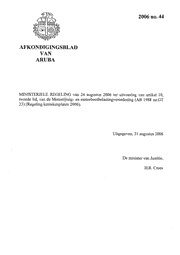
Afkondigingsblad van Aruba 2006 no. 44

Masters in Digital Marketing

Annamaachchaaryarin Kiirttanaikal’
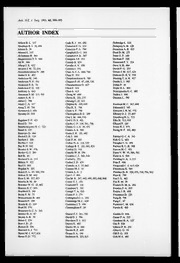
The Australian and New Zealand Journal of Surgery 1993: Vol 63 Index

Tirun-et’un-taand-t’akattil Akapporul’

International Political Science Review 1993: Vol 14 Index

Governing Natural Resources for Africa's Development
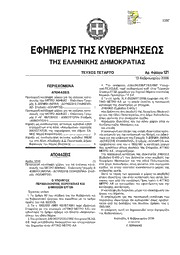
Greek Government Gazette: Part 4, 2006 no. 121

ERIC ED362642: Developments in the Curriculum for the Swedish MSc Programme in Agriculture.
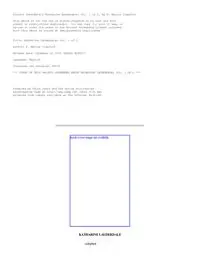
Katharine Lauderdale vol 1 of 2 by F Marion Crawford
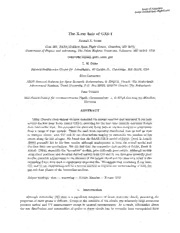
The X-ray Halo of GX5-1
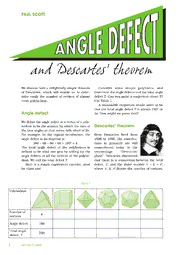
ERIC EJ743583: Angle Defect and Descartes' Theorem

Warning Order - Issue #16
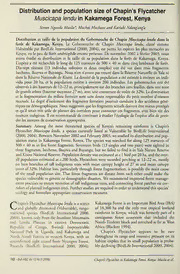
Distribution and population size of Chapin’s Flycatcher Muscicapa lendu in Kakamega Forest, Kenya
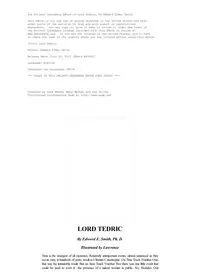
Lord Tedric by Edward E Smith Ph D

2008 Benjamin Menschel Fellowship exhibition catalog
